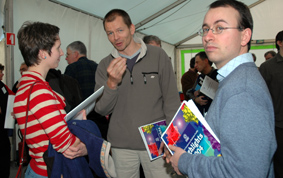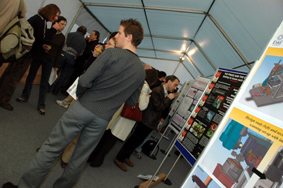- Home
- News
- General News
- The ESRF celebrates...
The ESRF celebrates its 15th Users’ Meeting looking towards the future
16-02-2005
Around 300 scientists from Europe, Canada, India, Japan, Russia and the USA attended the 15th ESRF Users’ Meeting, which took place on 8 and 9 February 2005 at the ESRF. The meeting focused on the Long-Term Strategy for the facility. There was also time to celebrate the first decade of users at the ESRF.
Last year, at the Users’ Meeting, the users were asked their point of view about the future development of the ESRF. They said that they wished for more beamtime and that it was important to retain the stability and reliability of the Machine as it is now. The ESRF, in the frame of this Long-Term Strategy, is considering how to do this. Some possibilities were presented this year; these included increasing the number of beamlines (around ten more) in order to provide the users with more beamtime, increasing the size of the Experimental Hall and opening the ESRF to new scientific communities.
Despite looking towards the future, the Users’ Meeting also considered the past decade since users started coming to the ESRF. In this sense, a speech full of humour was given by Massimo Altarelli, former Director of Research and now Senior Scientific Director of the Italian synchrotron ELETTRA. The ESRF Director General, Bill Stirling, pointed out that the number of scientific proposals has increased from 312 for six months in 1994 to 901 in the last six months of 2004.
The meeting also included a plenary talk by Fotis Kafatos, Director of the EMBL, entitled “Life Science in the early 21st century: an endless frontier”.


Joining scientific forces
An update of the status of the Partnership for Structural Biology (PSB) building was presented by Sine Larsen. The laboratory building will be ready by September or October 2005. It is named after a former Research Director at the ESRF, Carl-Ivar Brändén, who played a very important role in the development of structural biology at the ESRF. The PSB brings together the scientific expertise of different institutes in order to determine the structure of proteins and other macromolecules involved in biological processes.
At the present time there are discussions about creating a Partnership for Soft Condensed Matter and another one for Materials Science. These possible partnerships will mean new facilities. There is a joint project with the ILL and the EMBL to totally remodel the entrance of the ESRF. The entrance would be on the Avenue des Martyrs and the site would be equipped with a visitor centre, a new and bigger guest house, a new restaurant, a new auditorium for 400-500 people and buildings for new scientific partnerships.
With all these challenging goals for the future, the ESRF is an even more tempting institute for new countries to join. Discussions are taking place with Slovakia, Ireland, Greece and Latvia. Poland became a Scientific Associate of the ESRF in 2004, which increased to 18 the number of countries involved in the ESRF.



